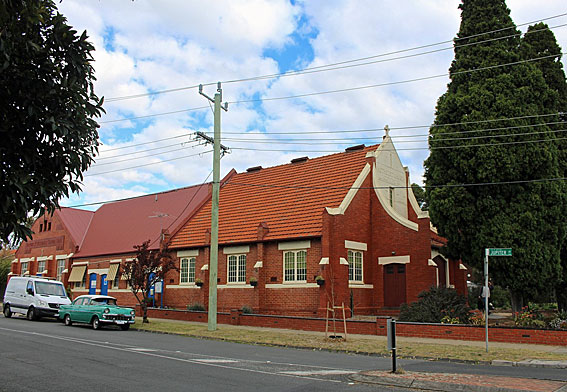
St Mary-the-Virgin Anglican-Catholic Church, Caulfield South: church exterior
[photograph by Trevor Bunning (September 2017)]

St Mary-the-Virgin Anglican-Catholic Church, Caulfield South: church exterior
[photograph by Trevor Bunning (September 2017)]
Historical and Technical Documentation by John Maidment
© OHTA (last updated March 2021)
St Mary-the-Virgin Anglican-Catholic Church was built as the Methodist Church, South Caulfield; the foundation stone was laid on 19 February 1921.1 The first pipe organ of unknown provenance was a small single-manual instrument that was sold to the Methodist Church, Oakleigh. The second pipe organ was built by C.W. Andrewartha, of Caulfield, and opened in June 1935.2 This was a seven-rank extension organ operating on tubular-pneumatic action and identical with the instrument installed in 1933 at St Margaret's Anglican Church, Ripley Grove, Caulfield, now at St Chad's Anglican Church, Chelsea. The contents of the organ were removed in 1981 by W.S. Glasson and used elsewhere. The fine blackwood case (three flats separated with fretwork panels) remains behind the reredos in the church.
| GREAT Open Diapason Stopped Diapason Salicional Principal Flute Swell to Great Swell Octave to Great SWELL Flute Sub Hohl Flute Salicional Gamba Celeste Flute Salicet Piccolo Closed Horn Tremulant PEDAL Bourdon Bass Flute Great to Pedal Swell to Pedal |
8 8 8 4 4 16 8 8 8 8 4 4 2 8 16 8 |
A B D A B C C D TC C D C B B |
Compass: 61/30
Tubular-pneumatic action
Stopkey console
3 thumb pistons to Great duplicated by combination pedals
3 thumb pistons to Swell duplicated by combination pedals
Balanced swell pedal
All ranks enclosed except Open Diapason and Bourdon notes 1-123
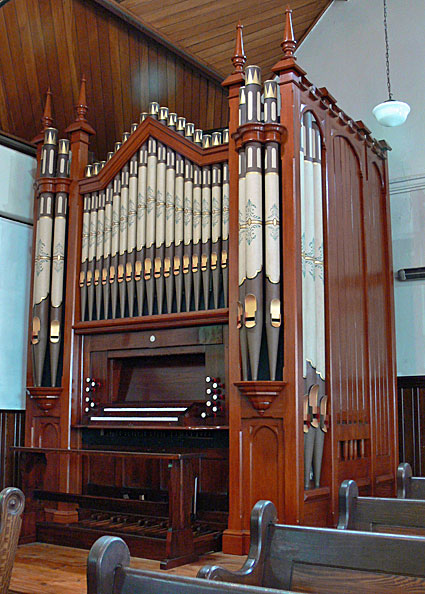
St Mary-the-Virgin Anglican-Catholic Church, Caulfield South: the organ case
[photograph by John Maidment (2 May 2014)]
The present organ is understood to have been built around 1886 by Alfred Crook, of Brunswick, for use in his residence.4 Later, Crook brought the instrument to the country town of Lockwood before its installation in the Congregational Church, Forest Street, Bendigo where it was opened on Friday 8 December 1893.5
THE CONGREGATIONAL CHURCH ORGAN RECITAL.
An organ recital and sacred concert, celebrating the opening of the new pipe organ, was given in the Congregational Church last night, when there was a crowded attendance. The organ is a very fine one, and is built on the latest principle by Messrs. Crook Bros. (late of Melbourne). The metal pipes have been specially imported from London, whilst the wooden pipes and all the mechanisms are made of well seasoned clear pine, consisting of the following:- Two manuals and full range of pedals, CCC to F; two open diapasons, great and swell; gamba 8 feet; keraulophon 8 feet; dulciana 8 feet; clarabella 8 feet; tremolo principal, 4 feet; flute 4 feet; fifteenth 2 feet; self acting coupler: bourdon 16 feet; couplers, great to swell; great to pedals; swell to pedals; four composition pedals and swell pedal.6
In 1938 it was placed in the Congregational Church, Olinda Street by Cyril Cowling and following an extensive renovation by members of the Society of Organists in Bendigo headed by Rae Anderson, and members of the local parish, in association with Hill, Norman & Beard (Australia) Pty Ltd, the organ was opened in St Peter's Church, Eaglehawk early in 1971.7 At the time, the keys were recovered, the pipework and action repaired, a new BOB blower and single-rise sprung reservoir provided, the casework repainted and the diapered front pipes restored. A former string rank on the swell was transposed to form a Twelfth and the whole organ revoiced.8 The rear wall of the swell box was moved backwards to accommodate the passage board. Departmental labels were placed on the console (some from the 1913 Norman & Beard organ at Melbourne Grammar School).9
The casework is delightfully designed and the façade pipes beautifully stencilled. The basses of the Open Diapason and Dulciana are placed at the side and surrounded by woodwork. The console shows a sense of care in its design and construction. One can see the influence of Melbourne organbuilder Alfred Fuller, who had built two organs in Brunswick at the time of Alfred Crook's work.
The organ was removed from Eaglehawk in 2013 as the church now serves as a neighbourhood centre. The whole was expertly restored by Wakeley Pipe Organs Pty Ltd in 2013-2014, this work including:
The gilding of the façade pipes was refurbished by Marc Nobel who also expertly grained the whole of the organ case and the two flats of wooden Dulciana pipes placed at the side. It now presents a most elegant appearance and the overall sound is delightful.10
| GREAT Open Diapason Dulciana Principal SWELL Open Diapason Stopd Bass Clarabella Gamba Flute Twelfth Fifteenth Tremolo PEDAL Bourdon COUPLERS Great to Pedal Swell to Pedal Swell to Great Swell Sub |
8ft 8ft 4ft 8ft 18ft 8ft 8ft 4ft [2-2/3] 2ft 16ft |
open wood bass TC CC-BB1 TC TC open wood TC* removed removed |
* transposed Keraulophon
Compass: 56/30
2 composition pedals to Great
2 composition pedals to Swell
Trigger swell lever
Mechanical key & stop action11
1 Details on foundation stone
2 The Argus, 8 June 1935, p.21
3 Details noted by John Maidment 1966 and subsequent conversation with W.S. Glasson
4 'Organ Restored', Bendigo Advertiser 24 March 1971
5 'Organ Recital', Bendigo Advertiser 9 December 1893, p.4
6 Bendigo Advertiser 10 December 1893, p.5
7 'Organ Restored', Bendigo Advertiser 24 March 1971
8 Personal communication Rae Anderson to John Maidment 1971
9 Details noted by John Maidment 28 September 2012
10 Details of restoration noted during visit by John Maidment 2 May 2014 in discussion with Ian Wakeley
11 Specification noted John Maidment June 1966, September 2012 and May 2014
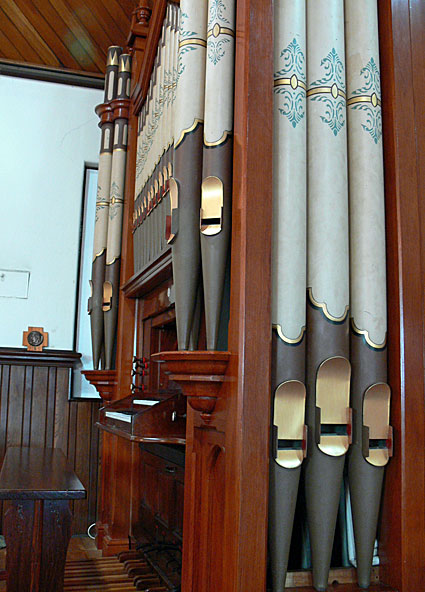
St Mary-the-Virgin Anglican-Catholic Church, Caulfield South: view of casework and console from right
[photograph by John Maidment (2 May 2014)]
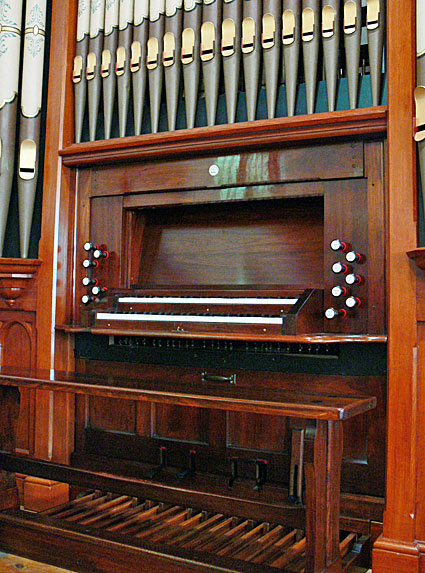
St Mary-the-Virgin Anglican-Catholic Church, Caulfield South: the console
[photograph by John Maidment (2 May 2014)]
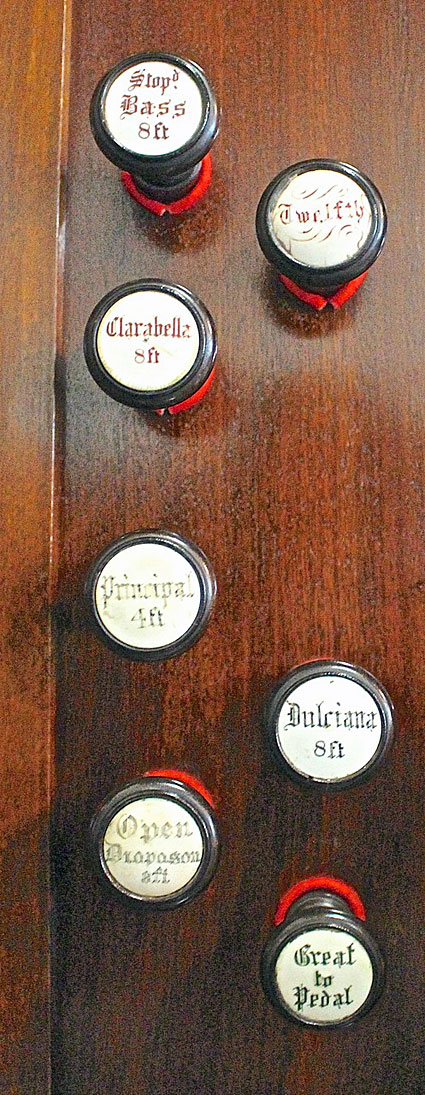
St Mary-the-Virgin Anglican-Catholic Church, Caulfield South: left hand stop jamb
[photograph by Trevor Bunning (September 2017)]
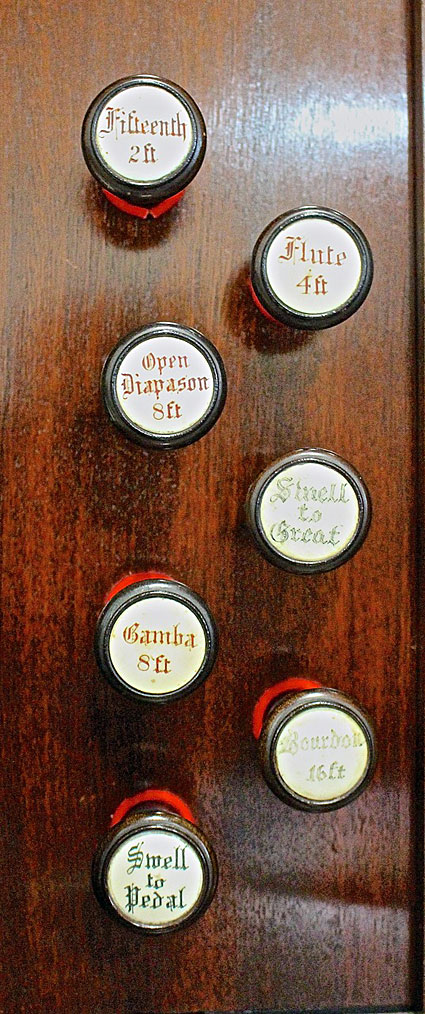
St Mary-the-Virgin Anglican-Catholic Church, Caulfield South: right hand stop jamb
[photograph by Trevor Bunning (September 2017)]
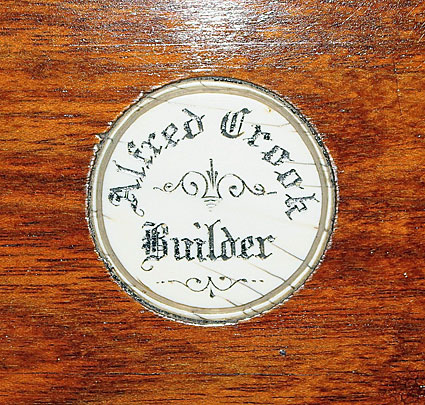
St Mary-the-Virgin Anglican-Catholic Church, Caulfield South: Alfred Crook nameplate
[photograph by Trevor Bunning (September 2017)]

St Mary-the-Virgin Anglican-Catholic Church, Caulfield South: view of internal pipework viewed through rear panels in swell box
[photograph by John Maidment (2 May 2014)]
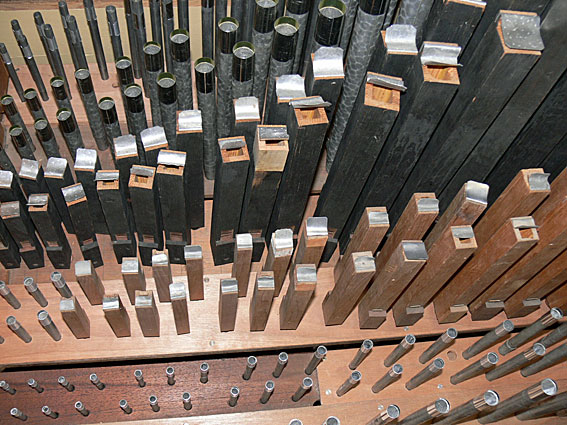
St Mary-the-Virgin Anglican-Catholic Church, Caulfield South: detailed view of internal pipework
[photograph by John Maidment (2 May 2014)]
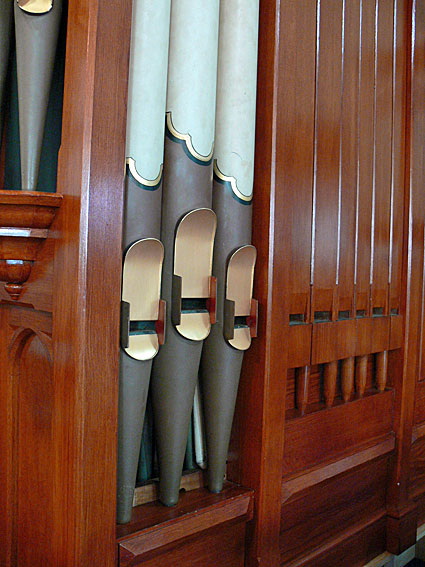
St Mary-the-Virgin Anglican-Catholic Church, Caulfield South: case detail
[photograph by John Maidment (2 May 2014)]